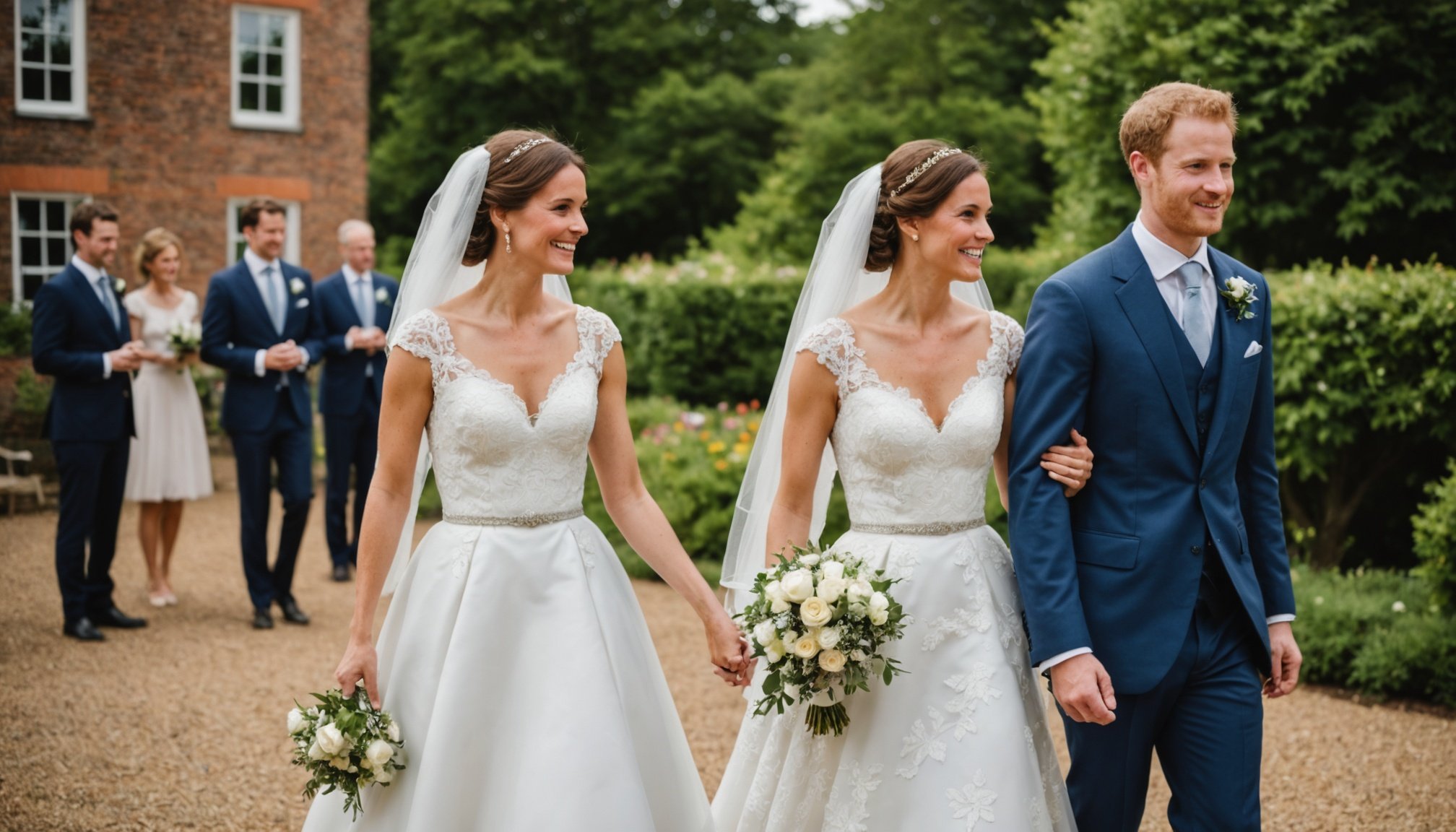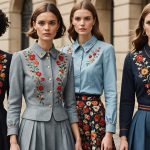History of Wearing White at UK Weddings
The history of white weddings traces back to Queen Victoria in 1840. Her choice to wear a white gown for her wedding to Prince Albert set a significant trend. Prior to this, brides wore colourful dresses, primarily reflecting their social status. Queen Victoria’s influence was profound in promoting the significance of the white dress, symbolising purity and innocence, which resonated with the British public and beyond.
Over time, the cultural significance of the colour white in Western weddings evolved. The white dress became synonymous with a new beginning, aligning with the broad concept of marriage as a pure commitment. Victorian ideals embedded the idea of exclusivity, something only the privileged could afford, making it a status symbol.
Also to discover : Master the Perfect Capsule Wardrobe for the UK’s Chameleon Climate: The Ultimate Guide
As society progressed, so did the perception of the white dress. The late 20th century marked a shift towards personal expression, yet the white dress continued to be a staple, supported by its tradition. Meanwhile, contemporary weddings sometimes embrace different colours and styles, yet the enduring charm and tradition of the white dress remains appealing, encapsulating both personal and societal meanings intertwined throughout history.
Rules and Etiquette for Guests Wearing White
Navigating the etiquette surrounding wedding guest attire can be tricky. A common question is: “Is it ever acceptable to wear white to a wedding?” Traditionally, white is reserved for the bride, making it generally unsuitable for guests. However, there are exceptions.
Topic to read : Top Eco-Friendly Women’s Shoes in the UK: Essential Features and Choices for a Sustainable Wardrobe
In some modern weddings, the couple may explicitly request guests to wear white, often as part of a thematic or monochrome aesthetic. Guests in this scenario should adhere to the couple’s guidelines and ensure that their outfit respects the occasion’s tone.
To avoid committing a fashion faux pas, consider these key points:
- Communicate with the couple: Understand their preferences. Some may embrace a relaxed approach to attire.
- Consider the setting: Informal beach weddings might welcome lighter colours, including white, to match the summery vibe.
- Avoid precise bride-copying styles: Even if wearing white is deemed appropriate, opt for simple designs that do not overshadow the bride’s ensemble.
Ultimately, respecting the couple’s wishes and the event’s tradition ensures a harmonious atmosphere. Balancing personal style while considering these factors is crucial, allowing guests to enjoy the celebration confidently and respectfully.
Specific Etiquette for the Bridal Party
When it comes to the bridal party attire, especially regarding wearing white, clarity is essential. Traditionally, white is the bride’s signature. However, modern weddings have seen shifts, occasionally incorporating white elements for the bridal party, such as the bridesmaids or even groomsmen. The key is clear communication with the bride to understand her vision.
Guidelines for Wearing White
- Discuss with the bride: Make sure whether she envisions the bridal party in white. This discussion ensures alignment with the overall theme and respects her wishes.
- Differentiating Attire: While the bride’s dress often stands out with intricate details or unique designs, bridal party attire should be more understated if white. This distinction maintains the bride’s prominence on her big day.
- Color Coordination: If white is part of the palette, consider incorporating other complementary colors or shades to diversify the look.
Bridal attire trends may lean towards variety in dress styles, fabric textures, or even accessories, providing individuality while honoring the event’s theme. Adopting these practices encourages a cohesive yet distinctive bridal party presence, aligning with contemporary and traditional elements of wedding fashion.
Fashion Tips for Wearing White at Weddings
When it comes to choosing a white dress for a wedding, understanding styles and fabrics that complement different body types is crucial. Opt for flowy fabrics like chiffon or silk for a romantic and flattering silhouette. For curvy figures, consider an empire waist style that emphasizes the bust while gracefully skimming over the midsection.
Accessorizing plays a vital role in enhancing your white outfit. Choose subtle accessories that add elegance without overshadowing the simplicity of white. For instance, a pair of pearl earrings or a dainty bracelet can complete the look without overpowering it. Don’t forget to add a pop of colour with a vibrant clutch or shoes for added charm.
Season-specific considerations are important when deciding on a white ensemble. In summer, lighter fabrics and simple designs keep you comfortable, while in winter, thicker materials like wool or a stylish white coat provide warmth. Layering is key during colder months; adding a cashmere shawl can create a classy yet cosy attire.
Preserving personal style while adhering to wedding fashion norms involves careful planning. Balance personal preferences with modest, timeless pieces, ensuring you respect the wedding’s traditional and formal setting.
Dos and Don’ts of Wearing White
Selecting the perfect white outfit for weddings demands careful consideration. First, let’s tackle the essential dos. Opt for subtle elegance—think minimalistic designs that do not compete with the bride’s attire. Layering soft fabrics like silk or lace can add dimension without overshadowing.
When it comes to accessorising, stick to refinements such as delicate jewellery or understated footwear which complement rather than dominate the ensemble. Balance is key, and adding a touch of colour through accessories can enliven the look without detracting from its elegance.
Turning to the common mistakes, a notable don’t is mimicking the bridal gown style. This faux pas can unintentionally shift the focus away from the bride. Equally, avoid overly intricate patterns or embellishments that might be too attention-drawing.
Ensuring alignment with the couple’s vision is crucial. Therefore, consult any theme considerations or attire guidelines outlined in the invitation. Balancing personal style with wedding decorum is vital; maintain respect for traditions while gently expressing individuality.
Ultimately, arranging attire with attention to these details empowers one to confidently enjoy the celebration while honouring the occasion’s formality and sentiment.
Cultural Variations in Wearing White
In different cultures, the perception of white in weddings varies significantly. While UK traditions often associate white with purity, in some cultures, it might symbolise mourning or neutrality. Understanding these nuances is crucial when attending international weddings.
In Eastern weddings, particularly in China and India, white can be a symbol of mourning. Brides typically wear vibrant colours like red or gold, symbolising prosperity and joy. In contrast, Western weddings traditionally view white as a representation of new beginnings and innocence.
Comparing UK and other traditions reveals fascinating differences. For instance, in Japan, brides may wear white during a Shinto ceremony, highlighting purity, but often change into richly coloured gowns later. Meanwhile, African weddings might feature elaborate traditional attire with a mix of bold colours and patterns, often reflecting cultural heritage and familial ties.
When invited to a wedding with diverse cultural backgrounds, it’s essential to respect local customs. Researching or consulting with the couple about attire preferences ensures a respectful homage to their traditions. Embrace vibrant and culturally significant motifs if encouraged, to demonstrate appreciation and respect. Balancing such awareness with personal style allows attendees to celebrate gracefully within any cultural context.
Resources for Planning Your Wedding Attire
Finding the perfect wedding attire can be a daunting task, but with the right bridal fashion consultants and resources, it becomes an exciting journey. For brides and guests alike, there is a wealth of wedding attire resources to explore, ensuring a look that complements the special day.
Consider starting with a list of reputable designers known for their bridal and guest attire. Designers like Jenny Packham and Stella McCartney offer collections that combine tradition with modern flair. For those on a budget, retailers such as ASOS and BHLDN provide stunning options at more affordable price points.
Engaging with professional bridal consultants can vastly simplify the process. These experts can guide you in selecting styles that flatter your figure and reflect your personal taste. They can also assist in coordinating the bridal party’s attire, maintaining a cohesive look throughout the event.
Additionally, numerous online resources and blogs offer inspiration and guidance. Websites such as The Knot and WeddingWire feature extensive galleries and articles on the latest trends in wedding fashion. These platforms also provide forums where brides can share experiences and tips, fostering a supportive community as you plan your dream wedding ensemble.










